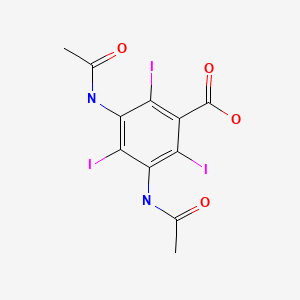Attribution Statement: LactMed is a registered trademark of the U.S. Department of Health and Human Services.
NCBI Bookshelf. A service of the National Library of Medicine, National Institutes of Health.
Drugs and Lactation Database (LactMed®) [Internet]. Bethesda (MD): National Institute of Child Health and Human Development; 2006-.
CASRN: 117-96-4

Drug Levels and Effects
Summary of Use during Lactation
Limited information indicates that maternal doses of diatrizoate up to 38 g (containing 18.5 grams of iodine) produce low levels in milk. In addition, because diatrizoate is poorly absorbed orally, it is not likely to reach the bloodstream of the infant or cause any adverse effects in breastfed infants. Guidelines developed by several professional organizations state that breastfeeding need not be disrupted after a nursing mother receives an iodine-containing contrast medium.[1-4]
Drug Levels
A woman who was 10 days postpartum received diatrizoate meglumine intravenously in a dose equivalent to 306 mg of iodine for phlebography. Bound iodine (presumably diatrizoate and any metabolites) in breastmilk was measured. Iodine was not found in the breastmilk until 2.25 hours after the dose when a concentration of 20 mg/L was detected. At 7 hours, a peak concentration of 22 mg/L occurred. Breastmilk iodine concentrations dropped after that until the concentration was 7.4 mg/L at 27 hours after the dose.[5]
One woman who was 7 weeks postpartum received 50 mL of an iodinated contrast medium containing 38 grams of sodium and meglumine salts of diatrizoate by rapid intravenous injection for urography (intravenous pyelogram; IVP). The total dose of iodine in this dose was 18.5 grams. Milk samples were expressed at 6, 9, 13 and 16.5 hours after the dose. Diatrizoate was undetectable (<2 mg/L) in any of the milk samples.[6]
A woman received 300 mL of sodium and meglumine salts of diatrizoate by intravenous injection for pulmonary angiography for a suspected pulmonary embolism 48 hours after delivery by cesarean section. This dose contained a total of 93 grams of iodine. All milk produced for the next 5 days (collection method not stated) was saved for analysis. The total amount of iodine excreted into milk during the first 24 hours after the dose was 31 mg or 0.03% of the dose administered. On the second and third days after administration, 0.008% (7.6 mg) and 0.0005% (0.5 mg), respectively, of the iodine dose was excreted in milk. By day 5, the concentration of iodine in milk was 119 mcg/L, compared to the mean of 70 mcg/L in 200 samples of normal breastmilk in the same laboratory.[7]
Infant Levels. Relevant published information was not found as of the revision date.
Effects in Breastfed Infants
Relevant published information was not found as of the revision date.
Effects on Lactation and Breastmilk
Relevant published information was not found as of the revision date.
Alternate Drugs to Consider
References
- 1.
- Webb JA, Thomsen HS, Morcos SK, et al. The use of iodinated and gadolinium contrast media during pregnancy and lactation. Eur Radiol. 2005;15:1234–40. [PubMed: 15609057]
- 2.
- Chen MM, Coakley FV, Kaimal A, et al. Guidelines for computed tomography and magnetic resonance imaging use during pregnancy and lactation. Obstet Gynecol. 2008;112:333–40. [PubMed: 18669732]
- 3.
- Copel J, El-Sayed Y, Heine RP, et al. Committee Opinion No. 723: Guidelines for diagnostic imaging during pregnancy and lactation. Obstet Gynecol. 2017;130:e210–e216. [PubMed: 28937575]
- 4.
- American College of Radiology Committee on Drugs and Contrast Media. Administration of contrast media to breast-feeding mothers. In, ACR manual on contrast media. 2022;Version 2022:106-7. https://www
.acr.org/Clinical-Resources /Contrast-Manual. - 5.
- Weyrauch U, Volkhardt V, Speck U. Rofo. 1977;127:275–6. [Transfer of amidotrizoate in maternal milk following phlebography in a patient 10 days post partum] [PubMed: 143435]
- 6.
- FitzJohn TP, Williams DG, Laker MF, et al. Intravenous urography during lactation. Br J Radiol. 1982;55:603–5. [PubMed: 7116094]
- 7.
- Texier F, Roque D'Orbcastel O, Etling N. Presse Med (Paris). 1983;19:769. [Stable iodine level in human milk after pulmonary angiography] [Letter] [PubMed: 6220321]
Substance Identification
Substance Name
Diatrizoate
CAS Registry Number
117-96-4
Disclaimer: Information presented in this database is not meant as a substitute for professional judgment. You should consult your healthcare provider for breastfeeding advice related to your particular situation. The U.S. government does not warrant or assume any liability or responsibility for the accuracy or completeness of the information on this Site.
- User and Medical Advice Disclaimer
- Drugs and Lactation Database (LactMed) - Record Format
- LactMed - Database Creation and Peer Review Process
- Fact Sheet. Drugs and Lactation Database (LactMed)
- Drugs and Lactation Database (LactMed) - Glossary
- LactMed Selected References
- Drugs and Lactation Database (LactMed) - About Dietary Supplements
- Breastfeeding Links
- PubChem SubstanceRelated PubChem Substances
- PubMedLinks to PubMed
- Review Iothalamate.[Drugs and Lactation Database (...]Review Iothalamate.. Drugs and Lactation Database (LactMed®). 2006
- Review Iodipamide.[Drugs and Lactation Database (...]Review Iodipamide.. Drugs and Lactation Database (LactMed®). 2006
- Review Ioxaglate.[Drugs and Lactation Database (...]Review Ioxaglate.. Drugs and Lactation Database (LactMed®). 2006
- Review Iohexol.[Drugs and Lactation Database (...]Review Iohexol.. Drugs and Lactation Database (LactMed®). 2006
- Review Iopromide.[Drugs and Lactation Database (...]Review Iopromide.. Drugs and Lactation Database (LactMed®). 2006
- Diatrizoate - Drugs and Lactation Database (LactMed®)Diatrizoate - Drugs and Lactation Database (LactMed®)
Your browsing activity is empty.
Activity recording is turned off.
See more...
